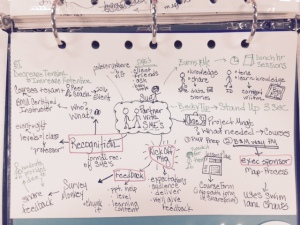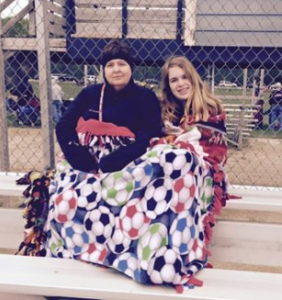I am a conference learner. I don’t always like every session but I get ideas, connect thoughts, and always apply something when I get home. DevLearn 2015 in Vegas was no different so here is my try to apply list:
- Design Mapping: I am already applying what I learned from David Anderson & Tom Kuhlman from Articulate. Before you design your course, design the design aka the look and feel of an eLearning course. This means color, font, images, elements, and the resources for ideas. My design map for an upcoming safety course was a hit with my sme and I have an idea of where I am headed on the screen.
- Comics: Michael Sheyahshe’s session might not have gone as planned but I bought Scott McCloud’s book that he suggested to learn more about comics. I got an app to read comics on my iPad. As I look to incorporate a comic look to a course I will remember his tip to SLOW DOWN animation and make it so my panels are “tap to zoom” for closer looks. I also liked his reference to the Ken Burns effect of doing a slow pan of a photo.
- Trina Rimmer’s session on Level Up Your eLearning gave me a lot of visual ideas. One take away was to use a game as pre-work to learn the terms you need in the rest of the course. The other key theme was for the learner to make choices that had risks/consequences. I can definitely add that to my safety training.
- Ron Price did a game session for Storyline2 users. My notes? Wow, there is a question bank? I have never clicked that. Not once. Add that to the list and maybe I too can create a cool game. geez louize.
- I should put David Anderson on retainer like a lawyer. After great design mapping info he added all kinds of other stuff to my brain in his Interactive Video in Storyline session. I will be looking to add video clips of our exec team in the onboarding course we have after watching one example. My fave though was a page he showed from the NY Times where you chose if the person in the video clip was lying or not. For me, the tech part of pausing a video might take some practice to use in a course.
- Robert Panetti shared his team’s work with a company in SharePoint. I have a few questions for our IT person and our internal communications person now. I think we could use the platform more effectively for creative content our learners access themselves. Related articles & videos can be featured in a way people want to click.
- Tracy Parish built a really cool course in WordPress so folks outside her company could access it. I loved the modules with assignments and how it encourages comments. Her tips on how to think through setting it up were very helpful and gave me a new way to think about “pages.” Best reminder, it is a webpage not a blog.
- I admit that the GameSalad session with Nick Floro was over my lack o’ tech head. It also did not help that I could not click along because my company firewall blocked the download. I am not really sure at this point how I would use one of these games. I am glad I saw it, have some pretty good notes on the choices to make, & know some other folks that have used it.
- Keynotes tend to be more inspirational than tangible. Adam Savage clearly imprinted on our minds that we need to tell our stories. When talking to a really technical sme, just keep parroting to check understanding. He was vulnerable, he was enthusiastic, and he was indeed inspiring.
- My colleagues again taught me that I am not alone. There are others who have not tried something, others who think the same way you do, and others that want to have the conversation with you. I am so grateful for these people in L&D.
So I leave another conference with lots of ideas, things to try, techniques I will reach out to colleagues to master, new friends, and definitely inspired. Thanks eGuild, it was great.







